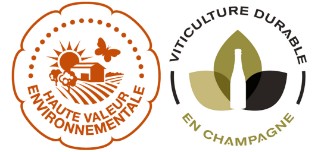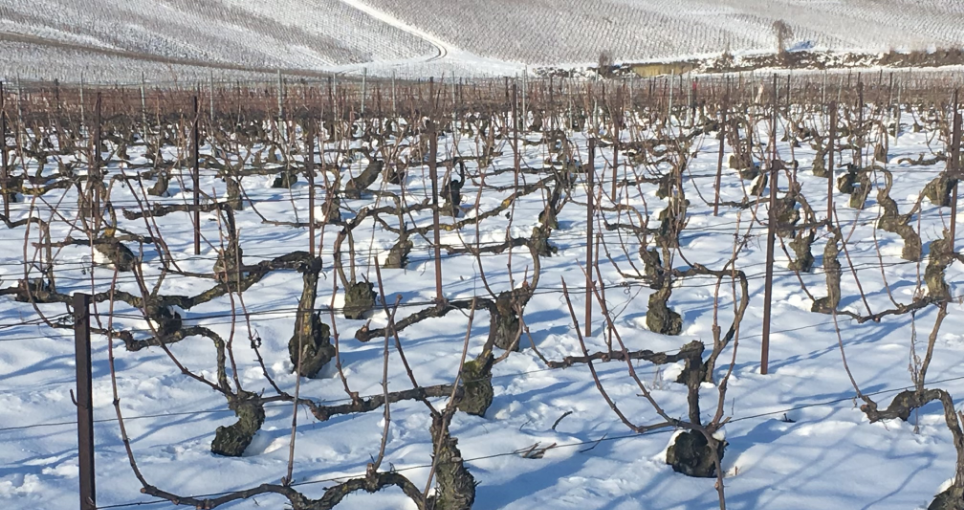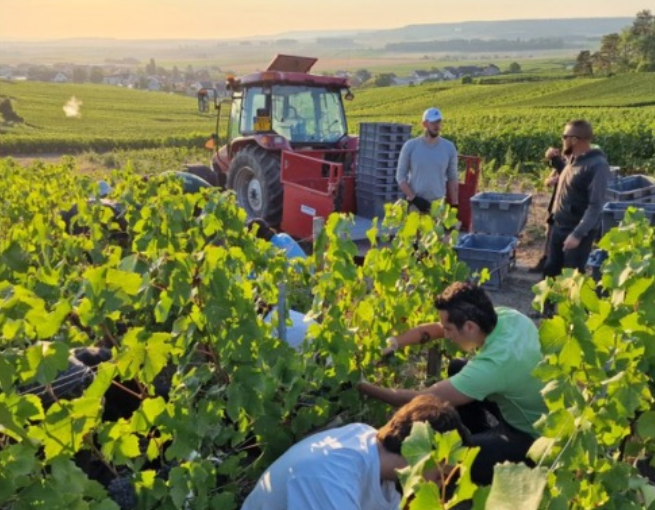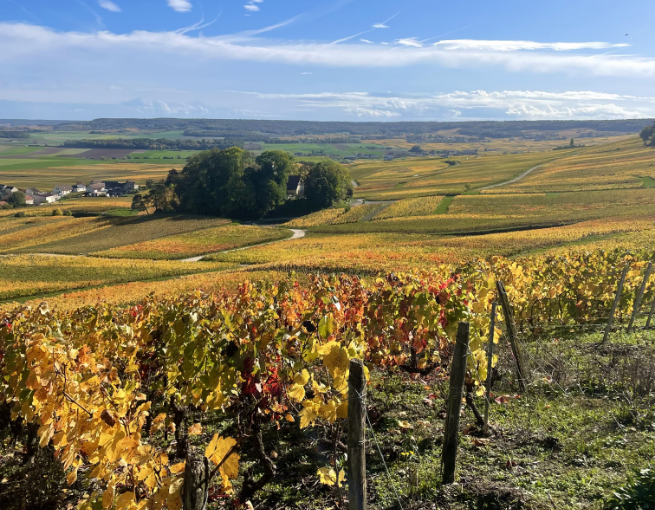The terroir
THE TERROIR
A BOND BETWEEN MAN AND THE SOIL
The notion of terroir is commonly associated with cultures, yet, this French word has no translation. How can one define it? Terroir includes specific characteristics of the soil, climate and biodiversity. In a nutshell, a terroir is a combination of know-how, production techniques and landscape. Terroir is cultural, as is the Champagne landscape, designed by man.
THE TERROIR
THREE VILLAGES
AND 36 PLOTS
The cellar at M. Brugnon & Fils is in Ecueil, however, its vineyard is spread over three « crus » and 36 plots of various size. The smallest one, Les aux Belles, in Ecueil, 6 ares 40, the biggest one, Les Vignes de l’Hôtel Dieu in Mont- Saint Père 1 hectare 30.
In total 8 hectares 60 are cultivated in the making of M. BRUGNON champagne. To put in context, the Champagne appellation surface area covers more than 34000 hectares and 310 « crus ».
SHORT HISTORY OF THE EXTENSION OF THE VINEYARD
For a long time, the vineyard had been confined to the village of Ecueil, but following the marriage of Marc BRUGNON to Michèle CHAUVET, in 1957, came a first extension to the village of Rilly La Montagne which today has 2 plots of Chardonnay, Les Babettes which are old vines planted in 1981, and the Maladries, a young plot, full of vitality, planted in 2006.
During the seventies, Marc and Michèle had the opportunity to buy plots in Mont-Saint Père. This « cru « from Aisne, on the banks of the Marne, where one of Marc’s sisters, married to Jean COMYN, lived. A visionary, Marc suggested that he and Jean buy the plots in that region, which had not been replanted since the Phylloxera crisis.
THREE GRAPE VARIETIES AND THREE TYPES OF SOIL
Ecueil is built on sandy soil and mainly yields Pinot Noir. This historic « cru » is used for our BRUT Réserve , our Rosé and our vintage blends in proportions relative to each vintage.
Rilly La Montagne is built on chalk soil. « Her majesty, chalk » of Champagne and supplies 100% of Chardonnay. This « cru » is the exclusive source of our vintage Blanc de Blancs.
Mont-Saint-Père lies largely on clay and limestone, with hard rock beneath and clay on top. This « cru » is used for 40% of our BRUT Réserve and Rosé. 20% of the Pinot Meunier grapes produced in this Marne Valley are sold on.
THE TERROIR
WHAT IS SUSTAINABLE VITICULTURE?
Sustainable viticulture, which calls for a responsible practise, aims to ensure the continuity of the vineyard and the wine grower’s income through regular quality production, while preserving the environment and its people. Launched in 2000, and already keenly followed by Alain, the framework for sustainable viticulture in Champagne revolves around 4 major themes:
• Inputs reduction and risk mitigation for health and the environment.
• Preservation and promotion of terroirs, biodiversity and landscapes
• Responsible management of water, effluents, by-products and waste.
• Energy and climate challenges: improvement of the sector’s carbon footprint.
Since 2018, la maison M. BRUGNON has been officially certified, according to this framework, but in reality, this best practise has been applied for the last twenty years on our land.

Seasons
KNOW-HOW AND TRADITION FROM SEASON TO SEASON

WINTER
For the wines, it’s the time for blending. The different tanks are tasted, analyzed, and blended according to family recipes, some of which remain unchanged, while others are adapted or reworked. Then comes the bottling, followed by aging in stacks for 3 to 5 years!
For a wine grower, everything starts with pruning. This is the gesture that will set the tone for the procedure to follow. It is tedious and solitary, but absolutely fundamental as it will determine a balanced growth. Once the pruning phase has been completed, the vine will be tied to a wire: this is called: training. For wine, it is time for blending. Different vats are tasted, analysed and blended according to family recipes, occasionally unchanged, and at times, adapted or revisited.
SPRING
The first disgorgement of the year, prepares the vintage that you will order for your springtime occasions. Pruning is over at the end of March, the sap has started to circulate again, and the buds are bursting. Young shoots rise up towards the sky with the zest of new life. The vineyard becomes a sea of green, and the race between the plant and man begins. The vine is a creeper that must be controlled and led right up to the grape harvest: this is known as work on the growing vine. The first de-budding consists in removing ‘greedy’ buds, in other words, non-fruit bearing buds, that grow on the vine and could attract the sap away from the main buds. Once again, this is meticulously done by hand and requires the expertise of the wine grower. Trellising keeps the vine vertical by tying it to a wire. This keeps the vine in shape and also clears the passage way for machines to get through.
By the end of spring, the vine has blossomed.
The first disgorgement of the year is used to prepare the cuvées that will be ordered for your spring celebrations.

SUMMER
As summer begins, work continues on the growing vine with trellising. This consists of separating the shoots and keeping them orderly by wiring and stapling. This procedure prevents leaves from crushing each other. The objective is to capture as much sunlight as possible, as it is in the leaves, that the sugar of the fruit is synthesized.
Topping is the summer pruning that starts at the end of June – beginning of July and lasts till the wine harvest. We get rid of the excess vegetation and look for the right balance, once again, between foliage and grape quantity. Topping is mostly done on a tractor, but is often finalised with clippers, by hand.
The date of the wine harvest by grape variety and by village, is determined by a group of volunteers who pick grapes in control plots for each appellation, and provide statistics on the sugar and acid content and weight of the bunch of grapes. This is the « MATU » network, as in maturity.


THE WINE HARVEST
With climate change, the beginning of the wine harvest has moved from autumn to summer. Precociousness has become the norm. But one thing that has not changed is the excitement around this time. It is the reward of a year’s labour.
Like everywhere in the region, grape picking is done by hand so that bunches are whole when brought to the wine press, as per the regulations. This prevents the maceration of the skin and the colouring of the juice. A team of twelve seasonal workers are hired every year, fed and lodged at the house. The quality of the work is fundamental and a warm welcome is non-negotiable, as far as we are concerned.
Grapes are driven from the plot to the nearest wine press: at the cooperative in Ecueil, or the family wine press in Rilly and Mont-Saint-Père.
AUTUMN
It is without a doubt the most beautiful season for the vines as they glow in a bed of red and gold. It’s the time for vinification, the juices have completed their first fermentation in steel vats and given a still wine which will be the basis for the future vintage.
This season is also the time to do some ground work: mowing, tillage or hoeing, the pruning stage is prepared by cutting the wood tops that will make the task easier. Diseased or dead vines are removed and possibly more planting.
The vineyard is inspected, and any disease symptoms observed and if necessary, conveyed to the collective supervisory body.
In the cellar, it’s all go: it’s time to get ready for Christmas!
